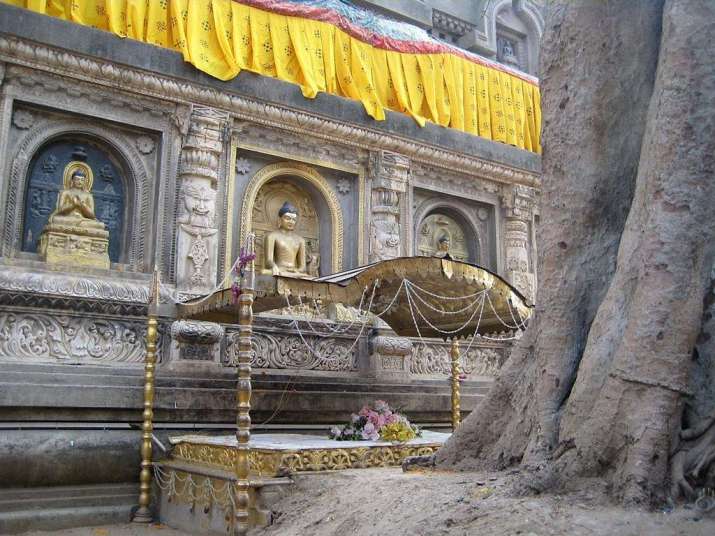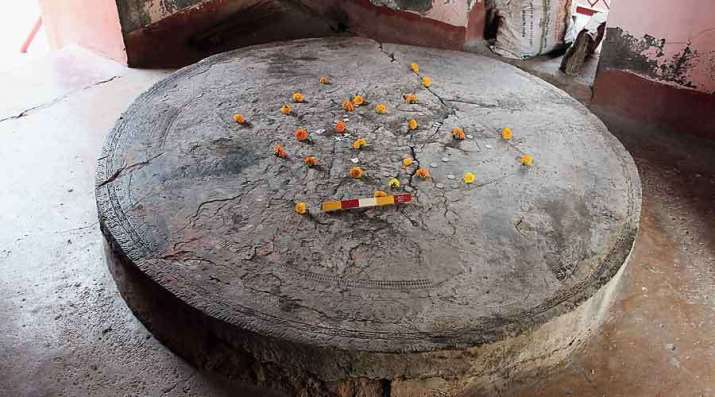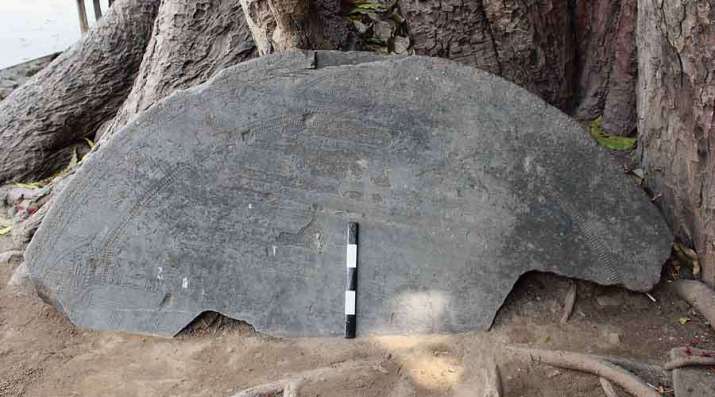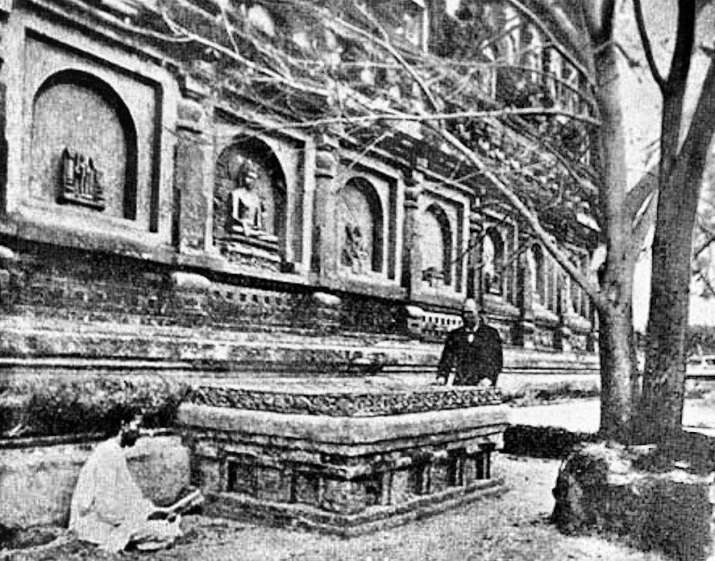NEWS
Archaeologist Claims to Have Identified Two Lost Vajrasanas in Bodh Gaya
 The Vajrasana or Enlightenment Throne of the Buddha in Bodh Gaya. From wikipedia.org
The Vajrasana or Enlightenment Throne of the Buddha in Bodh Gaya. From wikipedia.orgAn official from the Archaeological Survey of India (ASI) claims to have identified two lost vajrasana or Enlightenment Thrones of the Buddha in Bodh Gaya, according to local media reports.
Shanker Sharma, assistant superintending archaeologist with the ASI, a government agency under India’s Ministry of Culture that is responsible for archaeological research and conservation, recently announced that he had identified one vajrasana lying broken and ignored within the compound of the Mahabodhi Temple itself, and a second inside a nearby Hindu shrine, The Telegraph newspaper has reported.
Sharma said that he first identified what he believes to be the vajrasanas, also known as diamond thrones, in February, but independent verification was delayed by pandemic-related restrictions.
Three Enlightenment Thrones of the Buddha—ornately engraved stone plaforms—are believed to have been placed under the sacred Bodhi tree in Bodh Gaya by ancient monarchs to mark the bodhimanda or seat where the historical Buddha attained enlightenment.
 The Kushan-era vajrasana identified at the Vageshwari Devi temple in Bodh Gaya. From telegraphindia.com
The Kushan-era vajrasana identified at the Vageshwari Devi temple in Bodh Gaya. From telegraphindia.comThe first vajrasana, an ornate rectanglular platform of red sandstone that still sits beneath the Bodhi tree, adjacent to the Mahabodhi Temple, is thought to have originally been commissioned by the Mauryan emperor Ashoka in c. 260 BCE, some 200 years afterthe Buddha’s awakening. The vajrasana has been a focus for devotion since early Buddhist times as a symbol of the spot vacated by Shakyamuni Buddha, “where the essence of enlightenment is present.” (Thurman 138)
Two similar stone platforms are believed to have been missing for more than 100 years: the second vajrasana is thought to have been placed in the 1st–2nd century CE, during the time of the Kushan Empire; a third vajrasana was installed in the seventh century, although its origins are the subject of some debate.
The first director-general of the ASI, Sir Alexander Cunningham, unearthed the three vajrasanas during excavations at the Mahabodhi Temple in 1880–81. The original. commissioned by Ashoka was repositioned under the Bodhi tree, but records of the whereabouts of the other two were lost.
The ASI’s Sharma said he had consulted Cunningham’s excavation records, as well as travelogues penned by the Chinese pilgrims Fa Hien or Faxian (337–c.422) and Xuanzang (602–664) for descriptions of the vajrasanas in his investigation.
 The broken seventh-century vajrasana identified within the Mahabodhi Temple complex. From telegraphindia.com
The broken seventh-century vajrasana identified within the Mahabodhi Temple complex. From telegraphindia.com“I was going through Cunningham’s excavation records. While he discovered all three vajrasanas and reinstalled the one that belonged to Ashoka’s time, the other two simply fell off the radar and were forgotten,” Sharma was quoted as saying by The Telegraph. “This got me thinking about their whereabouts.” (The Telegraph Online)
Sharma subsequently announced that he had located the Kushan-era vajrasana “at the Vageshwari Devi (Saraswati) temple, located to the east of the Mahabodhi Temple.” (The Telegraph Online)
“It’s worshipped by the Hindus and matches the descriptions found in excavation records and travelogues,” Sharma was quoted as saying. “It was carved out of grey stone and is largely intact with some signs of weathering and possible marks of vandalism. It’s circular, with a 173-centimeter diameter and a thickness of 21 centimeters.” (The Telegraph Online)
The third vajrasana, also carved from grey stone, was found beneath a tree within the compound of the Mahabodhi Temple, although the intricate carvings have been all but obliterated by exposure to the elements and other damage.
“Nearly half of it is broken,” Sharma explained. “The part that remains is 146 centimeters long, 68 centimeters wide, and 16 centimeters thick.” (The Telegraph Online)
Still-visible carvings on the two vajrasanas include lotus petals, flowers, vines, vajras (symbolic thunderbolts), animals, and geometric shapes.
The chief monk of the Mahabodhi Temple, Bhikku Chalinda, noted that no decision had been made on what action to take regrading the stone platform inside the Vageshwari Devi temple: “One of them is at a nearby temple, which is not under our authority. The other is under a tree inside our temple compound. We’ll decide in a few days what to do with it.”
Sharma is reported to be preparing a report on his findings, which will be presented the 20th annual conference of the Indian Society for Buddhist Studies, to be held from 1–3 October in Nalanda.
“They are among the most sacred objects of worship in Buddhism. If they are stolen or damaged, it would be a big loss to the nation,” Sharma observed, adding that they should be “immediately moved to safety.” (The Telegraph Online)
 Sri Lankan Buddhist revivalist Anagarika Dharmapala (1864-1933) at the Vajrasana. From wikipedia.org
Sri Lankan Buddhist revivalist Anagarika Dharmapala (1864-1933) at the Vajrasana. From wikipedia.orgReferences
Thurman, Robert. 1992. The Holy Teaching of Vimalakīrti: A Mahāyāna Scripture. University Park, PA: Pennsylvania State University Press.
See more
ASI expert claims discovery of two lost vajrasanas in Bodhgaya (The Telegraph Online)
Related news reports from Buddhistdoor Global
Mahabodhi Temple in Bodh Gaya Reopens to the Public After Months of Lockdown
India’s Largest Reclining Buddha Statue to be Installed in Bodh Gaya
Renowned Buddhist Scholar Ven. Bhikshu Satyapala Dies in Bodh Gaya
32nd Nyingma Monlam Chenmo Underway in Bodh Gaya with Reduced Attendance Due to COVID-19 Restrictions
UPDATE: Lighting the Mahabodhi Project Draws Closer to Completion
Archaeological Survey of India Identifies Buddhist Settlement at Taranga Hills in Gujarat
Archaeological Survey of India to Develop Vikramshila Buddhist University Archaeological Site
Archaeological Survey of India to Retrace the Footsteps of Chinese Buddhist Missionaries














